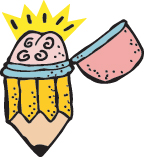Note that this is the second of a two-part exploration.
Dunning and Kruger, authors of the eponymous Dunning-Kruger Effect (Illusory Superiority) suggest that, across many intellectual and social domains, it is the poorest performers who hold the least accurate assessments of their skill and performances, grossly overestimating how well their performances stack up against those of their peers. These are the performers who not only perform poorly, but who believe they perform well. Or, put another way, clueless yet confident.
As they explain,
|
It seems that poor performers do not learn from feedback suggesting a need to improve. Hacker, Bol, Horgan, and Rakow (1) provided direct evidence for this failure to learn from feedback when they tracked students during a semester-long class. As time went on, good students became more accurate in predicting how they would do on future exams. The poorest performers did not— showing no recognition, despite clear and repeated feedback, that they were doing badly. [Why the unskilled are unaware: Further explorations of (absent) self-insight among the incompetent] |
 |
What is it that makes an illusion compelling? That is it not an obvious illusion — that it looks real. Consider Figure 1 below (an example of the checker shadow illusion). Look at the squares labeled “A” and “B”. Are they the same color?

Squares A and B are the same color.
Simply being told that squares A and B are the same color does not change what you see. We are, by and large, creatures who have evolved to assume that seeing or perceiving is believing.
To counter an illusion, you must find a way to demonstrate that it is illusory and not representative of reality. In Figure 2, the illusion is ‘broken’ by connecting the squares. It could also be broken by excising the two squares and laying them side-by-side, as in Figure 3:
Metaphorically, then, we insist that the learner grasp his or her illusion and manipulate it in such a way that the illusion becomes obvious and a vastly more realistic condition is perceived.
With respect to the Illusion of Superiority, this exploration is called self-validation of one’s learning (Faculty Guidebook 3.3.5) and there are seven techniques for performing this kind of validation:
|
|
Figures 2 and 3 could be seen as a transfer of contexts (Technique 2) — transferring the context of A to B and vice-versa. We can also measure the color of both squares A and B (both measure as #787878 in hexadecimal and 120,120,120 in RGB), thus implementing either Technique 3 or 4, depending on how we choose to frame it.
The point is that asking learners to validate their own learning by any or multiple of these techniques is the best way to help them move past the illusion of their superiority which effectively keeps them from accurately assessing their ability, improving their performance, and increasing their learning. That it is self-validation, done by the individual with a focus on the self is critical — the input, feedback, or information is not coming from an external source. Being told that you’re wrong is information that must internalized before it holds any meaning; realizing that you’re wrong is, by definition, already internal. The actual techniques for validating learning are then ways of breaking the illusion by making it real, moving it around, generalizing it, modeling it, looking closely at it, using it, and transferring ownership of it.
In what ways do you insist that your students validate their own learning?
[The explanation for how the illusion works (Technique 5) is available HERE.]
| 1 | Hacker, D. J., Bol, L., Horgan, D. D., & Rakow, E. A. (2000). Test prediction and performance in a classroom context. Journal of Educational Psychology, 92, 160–170. |






